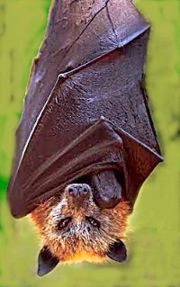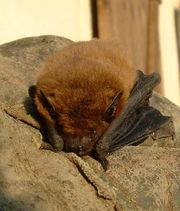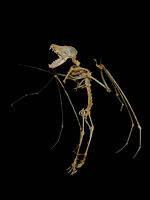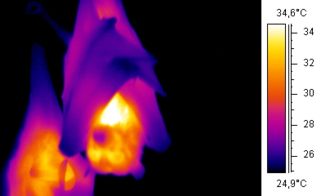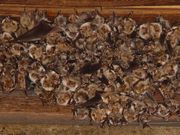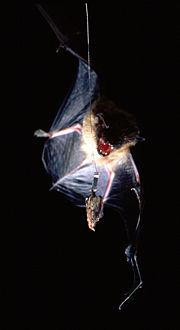Bat
2008/9 Schools Wikipedia Selection. Related subjects: Mammals
| Bats Fossil range: Late Paleocene - Recent |
||||||||||||
|---|---|---|---|---|---|---|---|---|---|---|---|---|
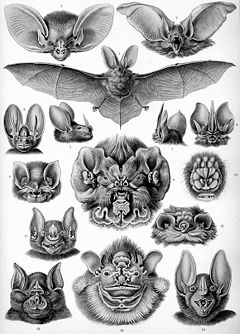 "Chiroptera" from Ernst Haeckel's Kunstformen der Natur, 1904
|
||||||||||||
| Scientific classification | ||||||||||||
|
||||||||||||
| Suborders | ||||||||||||
|
See article |
A bat is a mammal in the order Chiroptera. Their most distinguishing feature is that their forelimbs are developed as wings, making them the only mammals in the world naturally capable of flight (though other mammals, such as flying squirrels, gliding flying possums and colugos, can glide for limited distances). The word Chiroptera comes from the Greek words cheir "hand" and pteron "wing," as the structure of the open wing is very similar to an outspread human hand with a membrane ( patagium) between the fingers that also stretches between hand and body.
A measure of the success of bats is their estimated total of about 1,100 species of bats worldwide, accounting for about 20 percent of all mammal species. About 70 percent of bats are insectivores. Most of the rest are fructivores, with a few species being carnivorous. Bats are present throughout most of the world.
Bats perform a vital ecological role by pollinating some flowers, and also have an important role in seed dispersal; indeed, many tropical plants are totally dependent on bats. This role explains environmental concerns when a bat is introduced in a new setting. Tenerife provides a recent example with the introduction of the Egyptian fruit bat.
Fossil bats
Since bats are terrestrial and light-boned, there are few fossilized remains. An Early Eocene bat, Onychonycteris finneyi, was found in the 52-million-year-old Green River Formation in Wyoming (US) in 2003. The new genus was placed in a new family when it was published in Nature, February 2008.. It was clearly a flier, but the well-articulated skeleton showed underdeveloped cochlea of the inner ear, which provide echolocation capabilities in all modern true bats, demonstrating at last that flight in bats was developed before echolocation. The team realized Onychonycteris finneyi was different when they noticed that the species lacked the ear and throat features present in all living, echolocating bats today, and even in other ancient species.
The bats of 52.5 million years ago flew differently than the bats of today and looked vastly different too. Onychonycteris had claws on all five of its fingers, whereas modern bats have - at most - claws for only two digits on each hand. It also had longer hind legs, and shorter forearms, similar to those of climbing mammals that hang under branches (such as sloths or gibbons). This palm-sized animal had broad, short wings that suggest the it could not fly as fast or as far as those that evolved later. Instead of flapping its wings continuously while flying, it would likely have alternated flapping and gliding while in the air. These physical characteristics suggest that this species also did not fly as much as modern bats do; perhaps just flying to get from tree to tree, spending most of their waking day just climbing or hanging.
Another early Eocene fossil Icaronycteris index, was unearthed in 1960.
Classification and evolution
Bats are mammals. Though sometimes called "flying rodents", "flying mice," or even mistaken for insects and birds, bats are not, in fact, any of these things. There are two traditional suborders of bats:
- Megachiroptera (megabats)
- Microchiroptera (microbats/echolocating bats)
Despite the name, not all megabats are larger than microbats. The major distinction between the two suborders is based on other factors:
- Microbats use echolocation, whereas megabats do not (except for Rousettus and relatives).
- Microbats lack the claw at the second toe of the forelimb.
- The ears of microbats do not form a closed ring, but the edges are separated from each other at the base of the ear.
- Microbats lack underfur; they have only guard hairs or are naked.
Megabats eat fruit, nectar or pollen while microbats eat insects, blood (small quantities of the blood of animals), small mammals, and fish. While megabats have a well-developed visual cortex and show good visual acuity, microbats rely on echolocation for navigation and finding prey.
The phylogenetic relationships of the different groups of bats have been the subject of much debate. The traditional subdivision into Megachiroptera and Microchiroptera reflects the predominant view that suggests that these two groups of bats have evolved independently for a long time, from a common ancestor that was already capable of flight. This hypothesis recognizes the marked differences between microbats and megabats, while at the same time acknowledging the likelihood that flight has evolved only once in mammals. In addition, the majority of molecular biological evidence supports the point of view that bats form a monophyletic group (e.g. ).
More recently, researchers have proposed alternative views of chiropteran phylogeny (and classification), but more research is required to assess the merits of these proposals.
- Genetic evidence indicates that megabats should be placed within the four major lines of microbats, which originated during the early Eocene. This has resulted in a new classification, which includes two suborders: Yinpterochiroptera which includes the families Pteropodidae, Rhinolophidae, Megadermatidae, and Rhinopomatidae, and Yangochiroptera, including all other families of bats. Because these relationships combine echolocating and non-echolocating bats, it's unknown if the ancestor of bats possessed laryngeal echolocation and the bats of Pteropodiae subsequently lost it, or if this ability evolved twice.
- In the 1980s, it was hypothesized based on morphological evidence that Megachiroptera evolved flight separately from Microchiroptera. The so-called Flying primates theory proposed that when adaptations to flight are discounted in a cladistic analysis, the Megachiroptera are allied to primates by anatomical features that are not shared with Microchiroptera. For example, the brains of megabats show a number of advanced characteristics linking these animals to primates. Although recent genetic studies support the monophyly of bats, debate persists about the relative merits of DNA versus morphological evidence in settling this controversy.
Little fossil evidence exists about the evolution of bats, since their small, delicate skeletons do not fossilize well. However a Late Cretaceous tooth from South America resembles that of an early Microchiropteran bat. The oldest known definite bat fossils, such as Icaronycteris, Archaeonycteris, Palaeochiropteryx and Hassianycteris, are from the early Eocene (), but they were already very similar to modern microbats. Archaeopteropus, formerly classified as the earliest known megachiropteran, is now classified as a microchiropteran.
Bats are traditionally grouped with the tree shrews ( Scandentia), colugos ( Dermoptera), and the primates in superorder Archonta because of the similarities between Megachiroptera and these mammals. However, molecular studies have placed them as sister group to Ferungulata—a large grouping including carnivorans, pangolins, odd-toed ungulates, even-toed ungulates, and whales.
Below is the traditional classification of bats.
- Order Chiroptera (Ky-rop`ter-a) (Gr. cheir, hand, + pteron, wing)
- Suborder Megachiroptera ( megabats)
- Pteropodidae
- Suborder Microchiroptera ( microbats)
- Superfamily Emballonuroidea
- Emballonuridae ( Sac-winged or Sheath-tailed bats)
- Superfamily Molossoidea
- Antrozoidae ( Pallid bats)
- Molossidae ( Free-tailed bats)
- Superfamily Nataloidea
- Furipteridae ( Smoky bats)
- Myzopodidae ( Sucker-footed bats)
- Natalidae ( Funnel-eared bats)
- Thyropteridae ( Disk-winged bats)
- Superfamily Noctilionoidea
- Mormoopidae ( Ghost-faced or Moustached bats)
- Mystacinidae ( New Zealand short-tailed bats)
- Noctilionidae ( Bulldog bats or Fisherman bats)
- Phyllostomidae ( Leaf-nosed bats)
- Superfamily Rhinolophoidea
- Megadermatidae ( False vampires)
- Nycteridae ( Hollow-faced or Slit-faced bats)
- Rhinolophidae ( Horseshoe bats)
- Superfamily Rhinopomatoidea
- Craseonycteridae ( Bumblebee Bat or Kitti's Hog-nosed Bat)
- Rhinopomatidae ( Mouse-tailed bats)
- Superfamily Vespertilionoidea
- Vespertilionidae ( Vesper bats or Evening bats)
- Superfamily Emballonuroidea
- Suborder Megachiroptera ( megabats)
Megabats are primarily fruit- or nectar-eating. They have probably evolved for some time in New Guinea without microbat concurrention. This has resulted in some smaller megabats of the genus Nyctimene becoming (partly) insectivorous to fill the vacant microbat ecological niche. Furthermore, there is some evidence that the fruit bat genus Pteralopex from the Solomon Islands, and its close relative Mirimiri from Fiji, have evolved to fill some niches that were open because there are no nonvolant (non-flying) mammals in those islands.
Anatomy
By emitting high-pitched sounds and listening to the echoes, also known as sonar, microbats locate prey and other nearby objects. This is the process of echolocation, an ability they share with dolphins and whales. Two groups of moths exploit the bats' senses: tiger moths produce ultrasonic signals to warn the bats that the moths are chemically-protected ( aposematism) (this was once thought to be a form of " radar jamming", but this theory has been disproved); the moths Noctuidae have a hearing organ called a tympanum which responds to an incoming bat signal by causing the moth's flight muscles to twitch erratically, sending the moth into random evasive manoeuvres.
Although the eyes of most microbat species are small and poorly developed, leading to poor visual acuity, it is incorrect to assume that they are nearly blind. Vision is used as an aid in navigation especially at long distances, beyond the range of echolocation. It has even been discovered that some species are able to detect ultraviolet light. Their senses of smell and hearing are excellent.
The teeth of microbats resemble those of the insectivorans. They are very sharp in order to bite through the hardened armor of insects or the skin of fruits.
While other mammals have one-way valves only in their veins to prevent the blood from flowing backwards, bats also have the same mechanism in their arteries.
The finger bones of bats are much more flexible than those of other mammals. One reason is that the cartilage in their fingers lacks calcium and other minerals nearer the tips, increasing their ability to bend without splintering. The cross-section of the finger bone is also flattened instead of circular as is the bone in a human finger, making it even more flexible. The skin on their wing membranes is a lot more elastic and can stretch much more than is usually seen among mammals.
Because their wings are much thinner than those of birds, bats can manoeuvre more quickly and more precisely than birds. The surface of their wings are also equipped with touch-sensitive receptors on small bumps called Merkel cells, found in most mammals, including humans. But these sensitive areas are different in bats as each bump has a tiny hair in the centre, making it even more sensitive, and allowing the bat to detect and collect information about the air flowing over its wings. An additional kind of receptor cell is found in the wing membrane of species that use their wings to catch prey. This receptor cell is sensitive to the stretching of the membrane. The cells are concentrated in areas of the membrane where insects hit the wings when the bats capture them.
One species of bat has the longest tongue of any mammal relative to its body size. This is extremely beneficial to them in terms of pollination and feeding - their long narrow tongues can reach deep down into the long cup shape of some flowers. When their tongue retracts, it coils up inside their rib cage.
Reproduction
Mother bats usually have only one offspring per year, and they are viviparous. A baby bat is referred to as a pup. Pups are usually left in the roost when they are not nursing. However, a newborn bat can cling to the fur of the mother and be transported, although they soon grow too large for this. It would be difficult for an adult bat to carry more than one young, but normally only one young is born. Bats often form nursery roosts, with many females giving birth in the same area, be it a cave, a tree hole, or a cavity in a building. Mother bats are able to find their young in huge colonies of millions of other pups. Pups have even been seen to feed on other mothers' milk if their mother is dry. Only the mother cares for the young, and there is no continuous partnership with male bats.
The ability to fly is congenital, but at birth the wings are too small to fly. Young microbats become independent at the age of 6 to 8 weeks, megabats not until they are four months old. At the age of two years, bats are sexually mature.
A single bat can live over 20 years, but the bat population growth is limited by the slow birth rate.
Behaviour
Most microbats are active at night or at twilight.
Many bats migrate, while others pass into torpor in cold weather but rouse themselves and feed when warm spells permit insect activity. Yet others retreat to caves for winter and hibernate for six months. Bats rarely fly in rain- the rain interferes with their echo location, and they are unable to locate their food.
The social structure of bats varies, with some bats leading a solitary life and others living in caves colonized by more than a million bats. The fission-fusion social structure is seen among several species of bats. "Fusion" refers to the grouping of large numbers of bats in one roosting area and "fission" is the breaking apart and mixing of subgroups, with individual bats switching roosts with others and often ending up in different trees and with different roostmates.
Studies also show that bats make all kinds of sounds to communicate with others. Scientists in the field have listened to bats and have been able to identify some sounds with some behaviour bats will make right after the sounds are made.
70% of bat species are insectivorous, locating their prey by means of sonar. Of the remainder, most feed on fruits and their juices. Only three species sustain themselves with blood, some preying on vertebrates: these are the leaf-nosed bats (Phyllostomidae) of Central America and South America, and the two bulldog bat (Noctilionidae) species, which feed on fish. At least two species of bat are known to feed on other bats: the Spectral Bat, also called the American False Vampire bat, and the Ghost Bat of Australia. One species, the Greater Noctule bat, is believed to catch and eat small birds in the air.
As vectors for pathogens
Bats are natural reservoirs or vectors for a large number of zoonotic pathogens including rabies, severe acute respiratory syndrome (SARS), Henipavirus (ie. Nipah virus and Hendra virus) and possibly ebola virus. Their high mobility, broad distribution, and social behaviour (communal roosting, fission-fusion social structure) make bats favourable hosts and vectors of disease. Many species also appear to have a high tolerance for harbouring pathogens and often do not develop disease while infected.
Only 0.5% of bats carry rabies. However, of the very few cases of rabies reported in the United States every year, most are caused by bat bites. Although most bats do not have rabies, those that do may be clumsy, disoriented, and unable to fly, which makes it more likely that they will come into contact with humans. Although one should not have an unreasonable fear of bats, one should avoid handling them or having them in one's living space, as with any wild animal. If a bat is found in living quarters near a child, mentally handicapped person, intoxicated person, sleeping person, or pet, the person or pet should receive immediate medical attention for rabies. Bats have very small teeth and can bite a sleeping person without necessarily being felt. There is evidence that it is possible for the bat rabies virus to infect victims purely through airborne transmission, without direct physical contact of the victim with the bat itself.
If a bat is found in a house and the possibility of exposure cannot be ruled out, the bat should be sequestered and an animal control officer called immediately, so that the bat can be analysed. This also applies if the bat is found dead. If it is certain that nobody has been exposed to the bat, it should be removed from the house. The best way to do this is to close all the doors and windows to the room except one to the outside. The bat should soon leave.
Due to the risk of rabies and also due to health problems related to their faecal droppings ( guano), bats should be excluded from inhabited parts of houses. The Centre for Disease Control's website on bats and rabies provides full detailed information on all aspects of bat management, including how to capture a bat, what to do in case of exposure, and how to bat-proof a house humanely. In certain countries, such as the United Kingdom, it is illegal to handle bats without a license.
Where rabies is not endemic, as throughout most of Western Europe, small bats can be considered harmless. Larger bats can give a nasty bite. They should be treated with the respect due to any wild animal.
Cultural aspects
The bat is sacred in Tonga and West Africa and is often considered the physical manifestation of a separable soul. Bats are closely associated with vampires, who are said to be able to shapeshift into bats, fog, or wolves. Bats are also a symbol of ghosts, death, and disease. Among some Native Americans, such as the Creek, Cherokee and Apache, the bat is a trickster spirit. Chinese lore claims the bat is a symbol of longevity and happiness, and is similarly lucky in Poland and geographical Macedonia and among the Kwakiutl and Arabs. The bat is also a heraldic animal of the Spanish autonomous community of Valencia.
Pre-Columbian cultures associated animals with gods and often displayed them in art. The Moche people depicted bats in their ceramics.
In Western Culture, the bat is often a symbol of the night and its foreboding nature. The bat is a primary animal associated with fictional characters of the night, both villains like Dracula and heroes like Batman. The association of the fear of the night with the animal was treated as a literary challenge by Kenneth Oppel, who created a best selling series of novels, beginning with Silverwing, which feature bats as the central heroic figures much as anthropomorphized rabbits were the central figures to the classic novel Watership Down.
An old wives' tale has it that bats will entangle themselves in people's hair. One likely source of this belief is that insect-eating bats seeking prey may dive erratically toward people, who attract mosquitoes and gnats, leading the squeamish to believe that the bats are trying to get in their hair.
In the United Kingdom all bats are protected under the Wildlife and Countryside Acts, and even disturbing a bat or its roost can be punished with a heavy fine.
In Sarawak, Malaysia bats are protected species under the Wildlife Protection Ordinance 1998 (see Malaysian Wildlife Law). The large Naked bat (see Mammals of Borneo) and Greater Nectar bat are consumed by the local communities.
Bats can be a tourist attraction. The Congress Avenue bridge in Austin, Texas is the summer home to North America's largest urban bat colony, an estimated 1,500,000 Mexican free-tailed bats, which eat an estimated 10,000 to 30,000 pounds of insects each night. An estimated 100,000 tourists per year visit the bridge at twilight to watch the bats leave the roost.
Artificial roosts
Many people put up bat houses to attract bats just like many people put up birdhouses to attract birds. Reasons for this vary, but mostly centre around the fact that bats are the primary nocturnal insectivores in most if not all ecologies. Bat houses can be made from scratch, made from kits, or bought ready made. Plans for bat houses exist on many web sites, as well as guidelines for designing a bat house. Some conservation societies are giving away free bat houses to bat enthusiasts worldwide.
A bat house constructed in 1991 at the University of Florida campus next to Lake Alice in Gainesville has a population of over 100,000 free-tailed bats.
In Britain, pillboxes dating from World War II have been converted to make roosts for bats. Pillboxes that are well dug-in and thick walled are naturally damp and provide a stable thermal environment that is required by bats that would otherwise hibernate in caves. With a few minor modifications, suitable pillboxes can be converted to artificial caves for bats.

